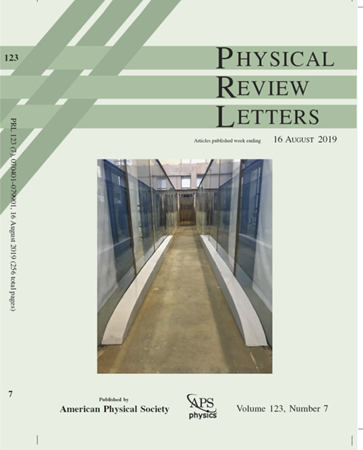Fock-Space Delocalization and the Emergence of the Porter-Thomas Distribution from Dual-Unitary Dynamics
IF 8.1
1区 物理与天体物理
Q1 PHYSICS, MULTIDISCIPLINARY
引用次数: 0
Abstract
The chaotic dynamics of quantum many-body systems are expected to quickly randomize any structured initial state, delocalizing it in the Fock space. In this Letter, we study the spreading of an initial product state in Hilbert space under dual-unitary dynamics, captured by the inverse participation ratios and the distribution of overlaps (bit-string probabilities). We consider the self-dual kicked Ising model, a minimal model of many-body quantum chaos that can be seen as either a periodically driven Floquet model or a dual-unitary quantum circuit. Both analytically and numerically, we show that the inverse participation ratios rapidly approach their ergodic values, corresponding to those of Haar random states, and establish the emergence of the Porter-Thomas distribution for the overlap distribution. Importantly, this convergence happens exponentially fast in time, with a timescale that is independent of system size. We inspect the effect of local perturbations that break dual unitarity and show a slowdown of the spreading in Fock space, indicating that dual-unitary circuits are maximally efficient at preparing random states. Our Letter establishes bridges between the dynamics of many-body systems and random matrix theory through the time evolution of structured initial states and finds natural applications in demonstrating a quantum advantage in random sampling and in benchmarking quantum devices.求助全文
约1分钟内获得全文
求助全文
来源期刊

Physical review letters
物理-物理:综合
CiteScore
16.50
自引率
7.00%
发文量
2673
审稿时长
2.2 months
期刊介绍:
Physical review letters(PRL)covers the full range of applied, fundamental, and interdisciplinary physics research topics:
General physics, including statistical and quantum mechanics and quantum information
Gravitation, astrophysics, and cosmology
Elementary particles and fields
Nuclear physics
Atomic, molecular, and optical physics
Nonlinear dynamics, fluid dynamics, and classical optics
Plasma and beam physics
Condensed matter and materials physics
Polymers, soft matter, biological, climate and interdisciplinary physics, including networks
 求助内容:
求助内容: 应助结果提醒方式:
应助结果提醒方式:


